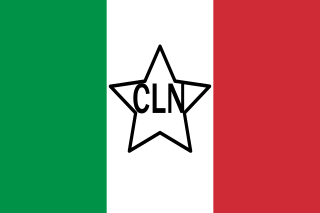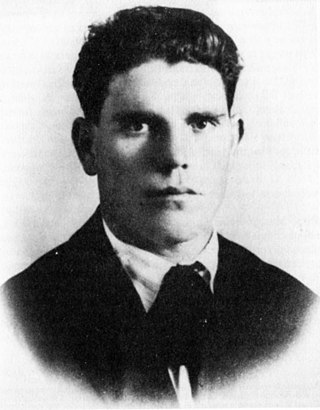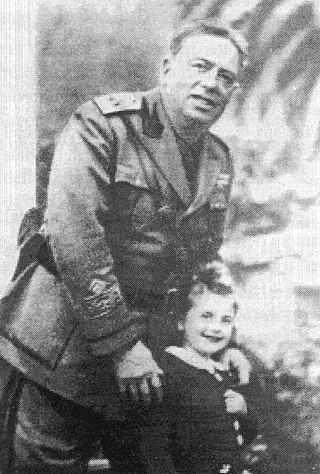Related Research Articles

The Italian Resistance consisted of all the Italian resistance groups who fought the occupying forces of Nazi Germany and the fascist collaborationists of the Italian Social Republic during the Second World War in Italy from 1943 to 1945. As a diverse anti-fascist and anti-nazist movement and organisation, the Resistenza opposed Nazi Germany and its Fascist puppet state regime, the Italian Social Republic, which the Germans created following the Nazi German invasion and military occupation of Italy by the Wehrmacht and the Waffen-SS from 8 September 1943 until 25 April 1945.
Italian anarchism as a movement began primarily from the influence of Mikhail Bakunin, Giuseppe Fanelli, Carlo Cafiero, and Errico Malatesta. Rooted in collectivist anarchism and social or socialist anarchism, it expanded to include illegalist individualist anarchism, mutualism, anarcho-syndicalism, and especially anarcho-communism. In fact, anarcho-communism first fully formed into its modern strain within the Italian section of the First International. Italian anarchism and Italian anarchists participated in the biennio rosso and survived Italian Fascism, with Italian anarchists significantly contributing to the Italian Resistance Movement. Platformism and insurrectionary anarchism were particularly common in Italian anarchism and continue to influence the movement today. The synthesist Italian Anarchist Federation appeared after the war, and autonomismo and operaismo especially influenced Italian anarchism in the second half of the 20th century.

The Arditi del Popolo was an Italian militant anti-fascist group founded at the end of June 1921 to resist the rise of Benito Mussolini's National Fascist Party and the violence of the Blackshirts (squadristi) paramilitaries. It grouped revolutionary trade-unionists, socialists, communists, anarchists, republicans, anti-capitalists, as well as some former military officers, and was co-founded by Giuseppe Mingrino, Argo Secondari and Gino Lucetti – who tried to assassinate Mussolini on 11 September 1926 – the deputy Guido Picelli and others. The Arditi del Popolo were an offshoot of the Arditi elite troops, who had previously occupied Fiume in 1919 behind the poet Gabriele d'Annunzio, who proclaimed the Italian Regency of Carnaro. Those who split to form the Arditi del Popolo were close to the anarchist Argo Secondari and were supported by Mario Carli. The formazioni di difesa proletaria later merged with them. The Arditi del Popolo gathered approximately 20,000 members in summer 1921.

The National Liberation Committee was a political umbrella organization and the main representative of the Italian resistance movement fighting against Nazi Germany's forces during the German occupation of Italy in the aftermath of the armistice of Cassibile, while simultaneously fighting against Italian fascists during the Italian Civil War. It coordinated and directed the Italian resistance and was subdivided into the Central Committee for National Liberation (CCLN), which was based in Rome, and the later National Liberation Committee for Northern Italy (CLNAI), which was based in Milan. The CNL was a multi-party entity, whose members were united by their anti-fascism.

Enrico Martini Mondovì, 29 January 1911 – Turkey, 19 September 1976) was an Italian soldier and partisan, an Alpini Major, founder of the 1 Group Alpine Divisions in the Italian Resistance, and a recipient of the Gold Medal of Military Valor.
The Italian Anarchist Communist Union, or Italian Anarchist Union, was an Italian political organization founded in Florence in 1919. It played an important role during the unrest of the Red Biennium, before it was suppressed by the fascist regime in 1926.
The Committee of National Liberation for Northern Italy was set up in February 1944 by partisans behind German lines in the Italian Social Republic, a German puppet state in Northern Italy. It enjoyed the loyalty of most anti-fascist groups in the region.

Anti-fascism is a political movement in opposition to fascist ideologies, groups and individuals. Beginning in European countries in the 1920s, it was at its most significant shortly before and during World War II, where the Axis powers were opposed by many countries forming the Allies of World War II and dozens of resistance movements worldwide. Anti-fascism has been an element of movements across the political spectrum and holding many different political positions such as anarchism, communism, pacifism, republicanism, social democracy, socialism and syndicalism as well as centrist, conservative, liberal and nationalist viewpoints.
Tigrino Sabatini, was a communist and a leader of the Italian Resistance, executed for his activities as a zone-commander of the Movimento Comunista d'Italia, also known as Bandiera Rossa.
The Italian partisan brigades were armed formations involved in the Italian resistance during the World War II.

The Brigate Garibaldi or Garibaldi Brigades were partisan units aligned with the Italian Communist Party active in the armed resistance against both German and Italian fascist forces during World War II.
The Brigate Osoppo-Friuli or Osoppo-Friuli Brigades were autonomous partisan formations founded in the headquarter of the Archbishop Seminary of Udine on 24 December 1943 by partisan volunteers of mixed ideologies, already active in Carnia and Friuli before the Badoglio Proclamation of 8 September. The partisans in this brigade adhered to various and often conflicting ideologies, including both secularism and Catholicism, as well as socialism and liberalism.

The history of women in the Italian Resistance plays a key role for the partisan movement in the fight against fascism during World War II. They fought to regain their country's freedom and justice by holding functions of primary importance.

Walkiria Terradura was an Italian anti-fascist partisan during the Second World War. She was awarded the Silver Medal of Military Valour.

Ugo Mazzucchelli was an Italian anarchist, anti-fascist and wartime partisan leader. He is best remembered as the commander of the Lucetti Battalion which became known as a tough opponent for the German and Fascist forces, when Italy became a critical battleground between 1943 and 1945, following the arrest of Mussolini.

Silvio Parodi was an Italian Fascist politician and soldier.

Pompeo Colajanni was an Italian politician and Resistance leader during World War II. After the war he held various political positions, including that of Undersecretary for Defense in the Parri and De Gasperi I cabinets and of member of the Italian Chamber of Deputies in 1975–1976.

Aligi Barducci was an Italian soldier and Resistance leader during World War II.
The Lucetti Battalion was an anarchist partisan brigade that operated in the surroundings of Carrara.
Pietro Bruzzi was an Italian mechanic, anarchist activist and partisan.
References
- ↑ "Circolo Anarchico Ponte Della Ghisolfa". isole.ecn.org. Retrieved 2022-10-02.
- ↑ Per Silvano Fedi si veda in Patria Indipendente 29 ottobre 2006, Resistenza italiana e rivoluzione - il sogno di Silvano Fedi, di Onofrio Gori Archived 16 August 2009 at the Wayback Machine
- ↑ "egisto gori". www.socialismolibertario.it. Archived from the original on 2021-04-16. Retrieved 2022-10-02.
- ↑ Archived 2021-12-04 at the Wayback Machine Il sogno rivoluzionario di Silvano Fedi, comunista libertario, eroe della Resistenza pistoiese. Parla Artese Benesperi, suo amico e compagno di lotta.
- ↑ si veda in Ducceschi e Fedi, due destini intrecciati? Archived 2022-10-04 at the Wayback Machine e il sito dedicato a Manrico Ducceschi Archived 2022-10-04 at the Wayback Machine
- ↑ "Recensioni" (PDF). Patria Indipendente (in Italian): 42. 2004-06-20. Archived from the original (PDF) on 2022-10-04.
- ↑ Per queste formazioni si veda, nel sito socialismo libertario.it, la nota su Anarchici a Carrara Archived 2022-07-15 at the Wayback Machine
- ↑ Mauro De Agostini, Franco Schirone, Per la rivoluzione sociale. Gli anarchici nella Resistenza a Milano (1943-1945), Zero in condotta, Milano, 2015.
- ↑ riferimento Archived 2013-10-23 at the Wayback Machine .bibliografia specifica T. Imperato, Anarchici a Torino: Dario Cagno e Ilio Baroni
- ↑ "biografia ANPI". Archived from the original on 2009-02-27. Retrieved 2022-10-02.
- ↑ "Don Pasquino Borghi - Biografia ANPI". Archived from the original on 2001-04-20. Retrieved 2024-06-03.
- ↑ "bollettino numero 2". Archived from the original on 2005-04-18. Retrieved 2022-10-02.
- ↑ da Biografia Eugenio Maggi Archived 2007-10-21 at the Wayback Machine
- ↑ "GLI ANARCHICI NELLA RESISTENZA". www.fdca.it. Archived from the original on 2020-09-28. Retrieved 2022-10-02.
- ↑ [ "Web Archive". Archived from the original on 17 October 2008. Retrieved 28 August 2008. biografia ANPI
- ↑ La storia del Circolo Giustizia e Libertà di Roma da ANPI Archived 2008-07-19 at the Wayback Machine
- ↑ biografia ANPI Archived 2008-10-17 at the Wayback Machine
- ↑ biografia ANPI Archived 2008-10-17 at the Wayback Machine